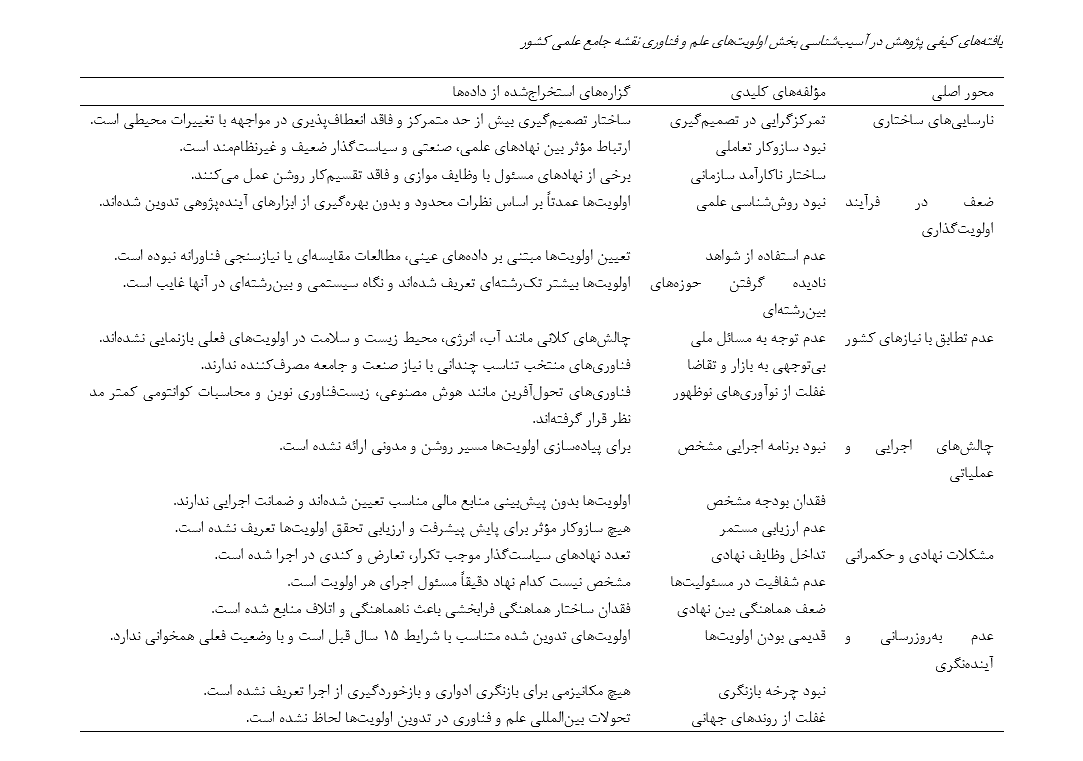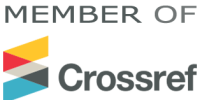آسیبشناسی بخش اولویتهای علم و فناوری نقشه جامع علمی کشور
کلمات کلیدی:
نقشه جامع علمی کشور, اولویتهای علم و فناوری, سیاستگذاری علم, تحلیل کیفی, حکمرانی نهادیچکیده
هدف این پژوهش، آسیبشناسی بخش اولویتهای علم و فناوری در نقشه جامع علمی کشور و ارائه راهکارهایی برای بهبود ساختار، محتوای و فرآیند تدوین این اولویتها است. این مطالعه با رویکرد کیفی و به شیوه تحلیل محتوای موضوعی انجام شده است. دادهها از طریق مصاحبههای نیمهساختاریافته با 18 نفر از خبرگان، سیاستگذاران و مدیران ارشد حوزه علم و فناوری گردآوری شد. نمونهگیری بهصورت هدفمند و تا رسیدن به اشباع نظری ادامه یافت. تحلیل دادهها با استفاده از کدگذاری باز و محوری انجام شد و در نهایت مقولههای اصلی و فرعی شناسایی گردیدند. نتایج پژوهش نشان داد که آسیبهای موجود در بخش اولویتهای نقشه جامع علمی کشور در شش محور اصلی قابل دستهبندیاند: نارساییهای ساختاری، ضعف در فرآیند تعیین اولویتها، عدم انطباق با نیازهای واقعی کشور، چالشهای اجرایی، ضعف در حکمرانی نهادی، و نبود نظام بهروزرسانی و آیندهنگری. هر محور شامل مؤلفههای متعددی نظیر تمرکزگرایی، عدم مشارکت ذینفعان، فقدان پیوست مالی، و بیتوجهی به فناوریهای نوظهور بود. بر اساس نتایج، بازطراحی فرآیند تعیین اولویتهای علم و فناوری کشور امری ضروری است. پیشنهاد میشود سازوکار مشارکت نهادی، روشهای دادهمحور و سازوکار بازخورد و ارزیابی مستمر برای تقویت کارایی سیاستهای علم و فناوری در کشور ایجاد شود.
دانلودها
مراجع
Altundağ, C. K., & Elmas, R. (2024). Multimedia Material for Science and Technology Teaching. 100-117. https://doi.org/10.4018/979-8-3693-3041-8.ch007
Asli, B., Eghbali, M., Ghamami, N., Abbasabad, H. D., Rasuli, B., & Rezaie, F. (2019). The Necessity of Developing Knowledge Map of the World in Earth Sciences and Mines Field Studies Based on Research Activities: A Case Study of Iran. Terrae Didatica, 15, e019007. https://doi.org/10.20396/td.v15i1.8654661
Azadi, P., Mesgaran, M. B., & Mirramezani, M. (2022). Research and Development Policy. 206-222. https://doi.org/10.11126/stanford/9781503630468.003.0010
Bahadori, M., Rezayat, S. M., Tabaei, S. F., & Farhud, D. D. (2020). Convergence Science to Transform Biomedicine: A Narrative Review. Iranian Journal of Public Health. https://doi.org/10.18502/ijph.v49i2.3084
Börner, K. (2020). Maps of Science, Technology, and Education. 597-615. https://doi.org/10.1093/oxfordhb/9780190251765.013.38
Catanzaro, M. (2022). ‘I Could Not Keep Silent’: Iranian Physicist Resigns to Join Protests. Nature, 610(7932), 430-430. https://doi.org/10.1038/d41586-022-03246-x
Ehteshamnejad, E., & Pakzad, M. (2024). Preparing an Optimal Organizational Structure for the Establishment of the Supreme Council of Science, Research, and Technology Fund. Jtesm, 3(5), 53-69. https://doi.org/10.61838/kman.jtesm.3.5.4
Ghazinoory, S., & Soofi, A. S. (2017). An Introduction to the Special Issue on Science and Technology in Iran. Technological Forecasting and Social Change, 122, 104-106. https://doi.org/10.1016/j.techfore.2016.09.019
Granell, C., & Aguilar‐Moreno, E. (2018). Geospatial Influence in Science Mapping. 3473-3483. https://doi.org/10.4018/978-1-5225-2255-3.ch302
HamidiMotlagh, R., Babaee, A., Maleki, A., & Isaai, M. T. (2020). Innovation Policy, Scientific Research and Economic Performance: The Case of Iran. Development Policy Review, 38(3), 387-407. https://doi.org/10.1111/dpr.12423
Heshmati, A., & Dibaji, S. M. (2019). Science, Technology, and Innovation Status in Iran: Main Challenges. Science Technology and Society, 24(3), 545-578. https://doi.org/10.1177/0971721819873192
Khosravi, M. (2022). Research Output of Iran Over the Past Two Years: Contributions From the European Journal of Translational Myology. European Journal of Translational Myology, 32(1). https://doi.org/10.4081/ejtm.2022.10447
Mahroyan, N., Mehraein, M., & Navabakhsh, M. (2021). Systematic Review of Studies on Science and Technology in Iran. Jarac, 3(4), 80-88. https://doi.org/10.61838/kman.jarac.3.4.7
Moaveni, B. (2021). Developed Technologies and Active Startup Companies in Dealing With COVID-19 Pandemic in Iran. Journal of Control, 14(5), 97-105. https://doi.org/10.52547/joc.14.5.97
Namdarian, L. (2017). Evaluation of Science, Technology, and Innovation (STI) in Iran. Collnet Journal of Scientometrics and Information Management, 11(2), 253-271. https://doi.org/10.1080/09737766.2017.1321728
Nazerian, R. (2024). Development of Two-Stage EBM Data Envelopment Analysis Model for Evaluation of Science and Technology Parks. Jes, 20(3), 4407-4418. https://doi.org/10.52783/jes.5769
Rahimi, A., Varmazyar, R., Ghalavand, H., & Shirshahi, S. (2024). Mapping and Analyzing the Scientific Outcomes of Medical Library and Information Sciences (1990–2022). Awari, 5, 1-13. https://doi.org/10.47909/awari.714
Rezaeisadrabadi, M. (2021). Science and Technology Parks and Incubators in Iran: Review. Roshd -e- Fanavari, 17(66), 53-62. https://doi.org/10.52547/jstpi.21008.17.66.53
Safaei, F., Abhari, K., Khosroshahi, N. K., Hosseini, H., & Jafari, M. (2019). Erratum: Optimisation of Functional Sausage Formulation With Konjac and Inulin: Using D-Optimal Mixture Design. Foods and Raw Materials, 439-439. https://doi.org/10.21603/2308-4057-2019-2-439
Shirshahi, S., Azad, R. V., & Riahinia, N. (2024). Mapping the Research Structure on Crohn’s Disease in PubMed and Web of Science (2014-2023). Awari, 5, 1-10. https://doi.org/10.47909/awari.47
Shojaee-Mend, H., Mahi, M., Khajavi, A., Maleki, M., & Nabiolahi, A. (2024). The Potential Use of Digital Health in Iran: A Systematic Mapping Review. Frontiers in Health Informatics, 13, 198. https://doi.org/10.30699/fhi.v13i0.583
Soofi, A. S., & Goodarzi, M. (2017). The Development of Science and Technology in Iran. https://doi.org/10.1057/978-1-137-57257-8
Tatfi, S. A. M. (2017). Regional Innovation System Analysis Model: The Case of Iran. Lebanese Science Journal, 18(2), 264-278. https://doi.org/10.22453/lsj-018.2.264-278
Yazdi, M. (2021). The History of Mineralogy and Gemology in Iran. Earth Sciences History, 40(2), 566-580. https://doi.org/10.17704/1944-6187-40.2.566

دانلود
چاپ شده
ارسال
بازنگری
پذیرش
شماره
نوع مقاله
مجوز
حق نشر 2025 Ehsan Ehteshamnejad ; Mahdi Pakzad (Author)

این پروژه تحت مجوز بین المللی Creative Commons Attribution-NonCommercial 4.0 می باشد.










